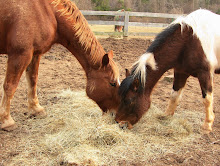Teaching Beginners to Ride
by
Jan Dawson
President, AAHS
[Reproduced from Caution:Horses, Vol. 1, No. 4 Summer/Fall 1996]
Among the problems demonstrated by the vast majority of beginning riders are the two most common reflexes: when something goes wrong beginning or novice riders seek a version of the fetal position, hands in their lap, hunched over the pommel, legs in the flanks, or when the horse moves suddenly and unexpectedly jerking the beginner's or novice rider's upper body out of position and the beginner moves his leg to compensate, which leaves her/him with neither upper body nor the leg where they should be. Either example will probably result in a fall and a fall that will be written off to a loss of balance, one of those things that just happens. These falls are unnecessary. They should not happen.
The early education of beginners is frequently dismissed in the United States, or at least it has been since the dissolution of the cavalry schools. If not forgotten or relegated to the lesser or less experienced instructors, they are all too often allowed to specialize too early. Often this early specialization is due to the fact that the instructor her/himself was allowed to specialize too early in a career and consequently neither has nor can teach solid, correct basics. This applies to western as well as English riding.
In order to build a strong base which will give the student a secure position from which to learn to ride, skills can only be successfully taught in one order. Each skill forms the foundation for the one above. When this is done it is possible to build a strong reliable seat quickly and efficiently thereby greatly shortening the length of time when beginners are so vulnerable. It may appear to be a slower method in the beginning and the gifted, natural riders might be able to sort things out for themselves, but average students will benefit because the length of time they are extremely vulnerable will be much shorter and their positions will be much stronger. Once this base or soft balanced seat is established these average students will usually overtake and pass others.
The Mexican vaquero, the precursor to the American cowboy, was a descendant of the Spanish clabber's or cavalry omcer who came straight out of the Spanish classical school of riding. 200 years ago there was no western/English distinction. When talking about basics, the part that the clinician or famous visiting riding instructor makes everybody do over, there is no difference between styles. The nonbeliever need only look at the various rule books, 4-H materials, and Pony Club books.
Look at the body alignment of each rider. Maybe there is a slight difference in stirrup length. Neck rein? Most modern western trainers ride two-handed at home. Cavalry Soldiers (in English or McClellan saddles) rode mostly one handed for obvious reasons. Until someone either takes a leg off the horse or adds an extra there is only one way to sit on him.
Instructors of beginners that find teaching beginners difficult, or who have problems that show up over and over often have this experience because they teach the required early skills out of order. This leads to many problems which are often attributed to other causes. Instructors of beginners who limit their lessons to start, stop and steer and maybe how to hold the reins and sitting up with "heels down" not only could be doing more, they are seriously short-changing their pupils. Experienced instructors express the importance of the "base" or the seat and leg. The reason that it is called a base is that is exactly what it is, a base or foundation for everything else. It must be in place before anything else can be added successfully.
The order in which the seat must go together is as follows:
1) Correct alignment: ear, shoulder, point of hip, back of heel in a line that is perpendicular to the horizon.
2) Drop the center of gravity as low as possible; while sitting this means a heavy seat - not an artificially depressed heel.
3) Unlock the lower back, if necessary, and teach the pupil(s) how to follow the movement of the horse's back with her/his seat.
4) Help the pupil learn to move his upper body around ever a correct leg to replace the instinct with a reflex that is safer: This is taught by means of a series of drills beginning at the standstill and being carried on through all three gaits. This can also be started in on-the-ground exercises.
5) Stabilize the lower leg absolutely at the trot. This can be done quickly if done by teaching a series of exercises and allowing the student to find the secure deep seat based on balance.
6) With a solid deep base or soft balanced seat the student will be able to have steady hands and legs that are free to communicate instructions to the horse who will be more comfortable, consequently safer, and able to do a better day's work.
7) For information on the exercises that can be used to teach these skills quickly and efficiently see the AAHS Handbook or contact the AAHS office for the clinician nearest you.






